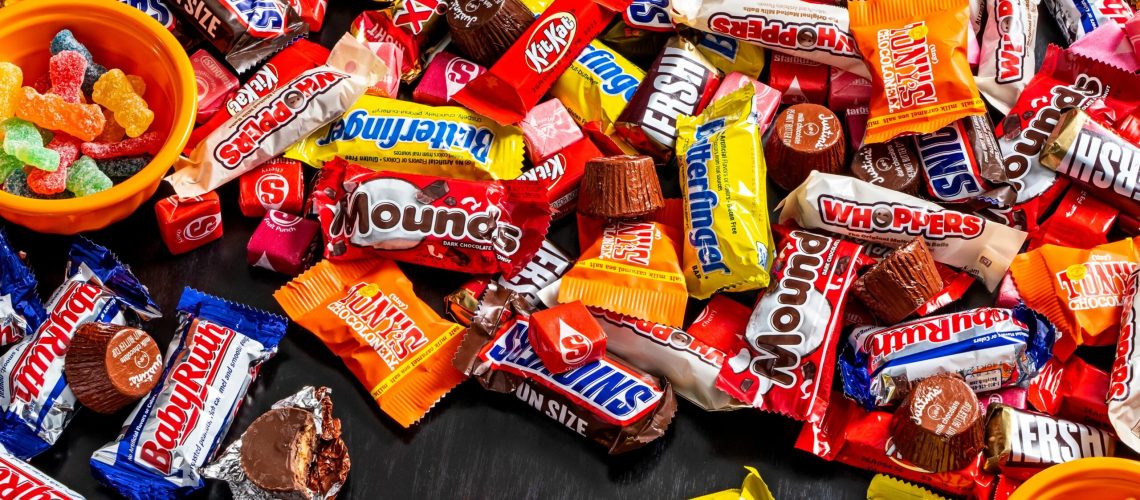October is here and the excitement is building for Halloween. Everywhere we look store shelves are filled with decorations, costumes and, of course, aisles of sweets and treats (and maybe some tricks too)! As a pediatric dietitian I know the biggest concern parents have is how to manage all those sweets. A great first step is to consider working on adjusting your mindset to one that supports Halloween being a learning opportunity for kids, versus a dreaded sugar-fest. It’s a great way to teach food neutrality, and to foster mindful eating practices.
Here are some ways to apply these skills before, during and after trick or treating!
Before Halloween
Leading up to Halloween we can start to practice referring to all the sweets and treats by their ACTUAL names. Instead of categorizing them as “bad”, “junk” and even “treats” we can call them what they are: candy, chocolate or chips. This essentially removes the moral value of the food and decreases their allure—it helps to put all foods on a level playing field. All foods provide the body with nutrients. They offer quick energy (carbohydrates) and some also provide other nutrients that help us feel satisfied like protein and fat. They also taste amazing and are fun to eat. All valuable!
On Halloween:
On Halloween, it’s a good idea to plan a filling and satisfying meal before heading out trick-or-treating. Offering a balanced dinner with a variety of nutrient dense foods will help to give your kids the energy for all of that walking, and help them to be a little more mindful when sampling their candy stash (because they won’t be starving). Consider including a source of protein, fat and fibre (all satiating nutrients). Some of our family favorites are chili with a roll, lentil soup with crackers and cheese or quesadillas with raw veggies and dip.
Let them enjoy and explore
When you make it home, have your child pour it out and sort through it! Honestly this is one of my favorite memories and then trading some with my siblings.
*Safety First! Discard any choking risks or remove any candy that has any of your child’s allergens if they have allergies*
It’s time to explore all the fun tastes and flavors. A great way to encourage bravery can be with trying new treat-type foods (you can model this too!). Your child may eat a lot, or maybe they will surprise you and eat less than you think, finding a point of satisfaction. It’s tempting to micromanage and restrict or limit the amount of candy your child consumes when they come home, but my suggestion is to just let them go to town. I promise you it will not negatively impact their health! It might actually help them get one step closer to feeling calm around treat foods.
If they happen to get uncomfortably full (which may happen!), it’s ok. It creates a great learning opportunity to discuss how they feel, and listen to our body’s cues. After all, there’s nothing quite like a natural consequence to teach you!
Storing their stash:
We all know that we want to support our child’s growth and development by providing a variety of nutrients through the food we offer. However, your child also needs to learn to manage treats so that they don’t feel deprived or restricted. A child who is deprived or restricted of treats (or any tempting food) will just want them more, and likely start begging, whining, sneaking and overconsuming food when they DO have access to it.
Consider the age of your child when it comes to how you store it. The recommendation is that children under 2 avoid added sugar (as much as possible), and preschoolers require some structure and guidance in managing how much and how often they can enjoy them. For school-aged children 4 and up, we can support them in self-managing their candy stash.
After the initial unlimited access on Halloween night, consider offering your child another opportunity for unlimited access for a snack the following day. Moving forward, include candy as part of meals and snacks along with other nutritious food like a glass of milk or a piece of fruit helps to devalue the sweets and treats. Don’t forget to continue to have unlimited access at snack times occasionally.
Bottom line
As a parent, your personal relationship with sweets and treats, in addition to the boundaries you set for your child, has a significant impact on how a child will develop their relationship with treats. Micromanaging, policing or demonizing these foods can lead to a disordered food relationship. When a child rarely sees these treat foods or is told they are “bad”, they won’t develop the skills to manage them in a positive way. This will continue into adulthood and can lead to obsessing or overindulging on these types of foods. The more opportunities to have access to these foods, the more these foods lose their excitement. It then becomes more about the memories than the food itself.

